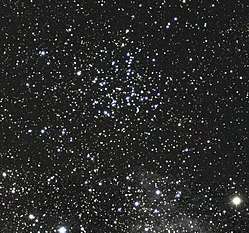HD 35519
 HD 35519 is the bright star next to the lower right corner in this picture of star cluster Messier 38 | |
| Observation data Epoch J2000 Equinox J2000 | |
|---|---|
| Constellation | Auriga |
| Right ascension | 05h 26m 54.31792s[1] |
| Declination | +35° 27′ 26.1799″[1] |
| Apparent magnitude (V) | 6.3062±0.0008[2] |
| Characteristics | |
| Spectral type | K7III[3] |
| U−B color index | +1.68[4] |
| B−V color index | +1.45[4] |
| Astrometry | |
| Radial velocity (Rv) | −20.34±0.31[2] km/s |
| Proper motion (μ) | RA: −14.10[1] mas/yr Dec.: −12.04[1] mas/yr |
| Parallax (π) | 5.0023 ± 0.0877[5] mas |
| Distance | 650 ± 10 ly (200 ± 4 pc) |
| Details | |
| Luminosity | 212[6] L☉ |
| Temperature | 4,160[6] K |
| Metallicity [Fe/H] | −0.084±0.093[7] dex |
| Other designations | |
| Database references | |
| SIMBAD | data |
HD 35519 is a giant star in the direction of open cluster Messier 38. It was once treated as a cluster member,[8] but is now know to be a foreground object.[5]
References
- 1 2 3 4 van Leeuwen, F. (2007), "Validation of the new Hipparcos reduction", Astronomy and Astrophysics, 474 (2): 653–664, arXiv:0708.1752, Bibcode:2007A&A...474..653V, doi:10.1051/0004-6361:20078357
- 1 2 Famaey, B.; et al. (2005). "Local kinematics of K and M giants from CORAVEL/Hipparcos/Tycho-2 data. Revisiting the concept of superclusters". Astronomy and Astrophysics. 430: 165–186. arXiv:astro-ph/0409579. Bibcode:2005A&A...430..165F. doi:10.1051/0004-6361:20041272.
- ↑ Sato, K.; Kuji, S. (November 1990), "MK classification and photometry of stars used for time and latitude observations at Mizusawa and Washington", Astronomy and Astrophysics Supplement Series, 85 (3): 1069–1087, Bibcode:1990A&AS...85.1069S
- 1 2 Johnson, H. L.; et al. (1966), "UBVRIJKL photometry of the bright stars", Communications of the Lunar and Planetary Laboratory, 4 (99), Bibcode:1966CoLPL...4...99J
- 1 2 Brown, A. G. A.; et al. (Gaia collaboration) (August 2018). "Gaia Data Release 2: Summary of the contents and survey properties". Astronomy & Astrophysics. 616. A1. arXiv:1804.09365. Bibcode:2018A&A...616A...1G. doi:10.1051/0004-6361/201833051.
- 1 2 McDonald, I.; et al. (2012), "Fundamental Parameters and Infrared Excesses of Hipparcos Stars", Monthly Notices of the Royal Astronomical Society, 427 (1): 343–57, arXiv:1208.2037, Bibcode:2012MNRAS.427..343M, doi:10.1111/j.1365-2966.2012.21873.x
- ↑ Taylor, B. J. (February 1999), "Catalogs of temperatures and [Fe/H] averages for evolved G and K stars", Astronomy and Astrophysics Supplement, 134: 523–524, Bibcode:1999A&AS..134..523T, doi:10.1051/aas:1999153
- ↑ Sowell, James R. (May 1987), "Yellow evolved stars in open clusters", Astrophysical Journal Supplement Series, 64: 241–267, Bibcode:1987ApJS...64..241S, doi:10.1086/191196
External links
This article is issued from
Wikipedia.
The text is licensed under Creative Commons - Attribution - Sharealike.
Additional terms may apply for the media files.